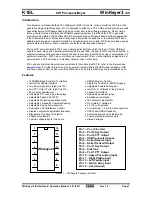
Manual 2100-614K
Page
11 of 61
B. If the space temperature rises above the
cooling setpoint of the MC4002, the unit
will receive a signal to operate in cooling
mode (Y1, Y2). The wall mount unit will still
receive a signal for dehumidification operation
(D) but the cooling call will override the
dehumidification call.
C. If the space temperature falls below the
heating setpoint of the MC4002, the unit
will receive a signal to operate in heating
mode (W). The wall mount unit will still
receive a signal for dehumidification operation
(D) but the heating call will override the
dehumidification call.
Hot gas reheat dehumidification operation is controlled
separately from the MC4002 using a humidistat and
remote communication regarding humidity level or
setpoint adjustment through SNMP or the webpages
is not possible. Emergency shutdown features of the
MC4002 will not shut down units connected to the
controller. Unit shutdown by removing the jumper
between the “R” and “RT” terminals on the unit
low voltage terminal strip and installing a relay to
disable unit low voltage power will shut down the units
connected to the MC4002 controller.
Each unit using hot gas reheat dehumidification
will require a separate humidistat. Dehumidification
staging is only possible by using offset values in each
humidistat. An example would be setting the first
humidistat/wall mount unit to 60% RH and the second
humidistat/wall mount unit to 65% RH. The first
humidistat/wall mount unit will operate when the room
reaches 60% RH. The second humidistat/wall mount
unit will operate when the room reaches 65% RH. The
lead unit regarding dehumidification operation will not
rotate.
COOLING OPERATING SEQUENCES
FOR ALTERNATING LEAD/LAG/LEAD/
LAG CONFIGURATION
1. 1-Stage Compressor Units No Economizer
1
st
stage cooling setpoint is the setting (SP) input into
the controller. Factory default is 77F (25C). On a call
for cooling the blower of the lead unit will come on
immediately (if not already on – See Blower Operation),
and the Stage 1 LED will blink for 10-seconds before
going solid, at which time the compressor will start.
2
nd
cooling setpoint is 4F (default setting, user
selectable 2-6F) warmer than Stage 1. On a call for 2
nd
Stage cooling the blower of the lag unit is turned on (if
not already on – See Blower Operation), and the Stage
2 LED will blink for 10-seconds before going solid, at
which time the compressor will start.
3
rd
and 4
th
stages are functional outputs but there is
nothing to be controlled.
2. 2-Stage Compressor Units No Economizer
1
st
stage cooling setpoint is the setting (SP) input into
the controller. Factory default is 77F (25C). On a call
for cooling the blower of the lead unit will come on
immediately (if not already on – See Blower Operation),
and the Stage 1 LED will blink for 10-seconds before
going solid, at which time the lead unit compressor will
start in compressor Stage 1 partial capacity operation.
2
nd
cooling setpoint is 4F (default setting, user
selectable 2-6F) warmer than Stage 1. On a call for
2
nd
Stage cooling the blower of the lag unit is turned
on (if not already on – See Blower Operation), and the
Stage 2 LED will blink for 10-seconds before going
solid, at which time the lag unit compressor will start
in compressor Stage 1 partial capacity operation.
3
rd
cooling setpoint is 2F (default setting, user
selectable 2-3F) warmer than Stage 2. On a call for
3
rd
Stage cooling the Stage 3 LED comes on solid (no
delay), and the lead unit compressor will switch to
compressor Stage 2 full capacity operation.
4
th
cooling setpoint is 2F (default setting, user
selectable 2-3F) warmer than Stage 3. On a call for
4th Stage cooling the Stage 4 LED comes on solid
(no delay), and the lag unit compressor will switch to
compressor Stage 2 full capacity operation.
IMPORTANT
Balanced Climate
TM
mode is not available when W**AC
series units are used with the MC4002 controller.
Humidity controller setpoint should be in 50-60% rel-
ative humidity area: Setting controller to lower settings
will result in excessive operating time and operating
costs for the electric reheat, and in extreme cases
could cause evaporator (indoor) coil freeze-up if there
are periods of light internal equipment (heat) loading.
CAUTION












































